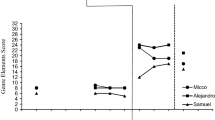Abstract
Interpreting and describing complex information are essential skills for effective functioning in many academic and occupational settings. For example, undergraduate psychology students must often interpret and describe the complex interactive effects of at least two variables on behavior. This experiment described a new procedure that enhanced the emergence of this difficult-to-learn skill: the prior training of selection-based conditional discriminations between graphs of interactions and their printed descriptions. The accuracy and completeness of written descriptions for students who received standard conditional discrimination training procedures were very low and no better than those obtained from students who were in a test–retest control group. Two other specially designed conditional discrimination conditions involved training that established explicit control by many elements in the graphs and their corresponding textual elements in the printed descriptions of the graphs. These groups showed notable improvements in their written descriptions. The behavioral mechanisms responsible for these effects are discussed. Finally, these findings might inform the development of instructional packages to reliably induce this complex communicational repertoire in a variety of content areas.





Similar content being viewed by others
References
Alonso-Alvarez, B., & Perez-Gonzalez, L. A. (2006). Emergence of complex conditional discriminations by joint control of compound samples. The Psychological Record, 56, 447–463.
Alonso-Alvarez, B., & Perez-Gonzalez, L. A. (2011). Derived control by compound and single sample stimuli in a matching-to-sample task in children. Psicothema, 23, 415–423.
Behavior Analyst Certification Board. (2012). Fourth edition task list. Retrieved from http://www.bac.com/Downloadfiles/TaskList/Fourth_Edition_Task_List.pdf
Cooper, J., Heron, T., & Heward, W. (2007). Applied behavior analysis. New Jersey: Pearson Education.
Fields, L., Adams, B. J., Buffington, D. M., Yang, W., & Verhave, T. (1996). Response transfer between stimuli in generalized equivalence classes: A model for the establishment of natural kind and fuzzy superordinate categories. The Psychological Record, 46, 665–684.
Fields, L., & Spear, J. (2012). Measuring joint stimulus control by complex graph/description correspondences. The Psychological Record, 62, 279–294.
Fields, L., Travis, R., Roy, D., Yadlovker, E., de Aguiar-Rocha, L., & Sturmey, P. (2009). Equivalence class formation: A method for teaching statistical interactions. Journal of Applied Behavior Analysis, 42, 575–593. doi:10.1901/jaba.2009.42-575 DOI:10.1901%2Fjaba.2009.42-575#pmc_ext.
Garfield, J., & Ahlgren, A. (1988). Difficulties in learning basic concepts in probability and statistics: Implications for research. Journal for Research in Mathematics Education, 19(1), 44–63.
Garfield, J., & Chance, B. (2000). Assessment in statistics education: Issues and challenges. Mathematical Thinking and Learning, 2, 99–125. doi:10.1207/S15327833MTL0202_5.
Goldstein, H. (1983). Recombinative generalization: Relationships between environmental conditions and the linguistic repertoires of language learners. Analysis and Intervention in Developmental Disabilities, 3, 279–293. doi:10.1016/0270-4684(83)90002-2.
Goldstein, H. (1985). Enhancing language generalization using matrix and stimulus equivalence training. In S. F. Warren & A. K. Rogers-Warren (Eds.), Teaching functional language: Generalization and maintenance of language skills (pp. 225–249). Baltimore, MD: University Park Press.
Hull, C. L. (1920). Quantitative aspects of the evolution of concepts: An experimental study. Psychological Monographs, 28, 1–86. doi:10.1037/h0093130.
Iversen, I. H., Sidman, M., & Carrigan, P. (1986). Stimulus definition in conditional discriminations. Journal of the Experimental Analysis of Behavior, 45, 297–304.
Keller, F. S., & Schoenfeld, W. N. (1950). Principles of psychology: A systematic text in the science of behavior. East Norwalk, CT: Appleton-Century-Crofts.
McBurney, D. H., & White, T. L. (2010). Research methods (8th ed.). New York, NY: Wadsworth/Thompson Learning.
Mulhern, G., & Wylie, J. (2004). Changing levels of numeracy and other core mathematical skills among psychology undergraduates between 1992 and 2002. British Journal of Psychology, 95, 355–370. doi:10.1348/0007126041528176.
Perez-Gonzalez, L. A., & Alonso-Alvarez, B. (2008). Common control by compound samples in conditional discriminations. Journal of the Experimental Analysis of Behavior, 90, 81–101.
Reyes-Giordano, K., & Fienup, D. M. (2015). Emergence of topographical responding following equivalence-based neuroanatomy instruction. The Psychological Record. Retrieved from http://link.springer.com/article/10.1007%2Fs40732-015-0125-4#. doi:10.1007/s40732-015-0125-4.
Sella, A. C., Ribeiro, D. M., & White, G. W. (2014). Effects of an online stimulus equivalence teaching procedure on research design open-ended questions performance of international graduate students. The Psychological Record, 64, 89–103. doi:10.1007/s40732-014-0007-1.
Sidman, M. (1971). Reading and auditory-visual equivalences. Journal of Speech and Hearing Research, 14, 5–13.
Sidman, M., & Cresson, O. (1973). Reading and crossmodal transfer of stimulus equivalences in severe retardation. American Journal of Mental Deficiency, 5, 515–523.
Skinner, B. F. (1957). Verbal behavior. Acton, MA: Copley. doi:10.1037/11256-000.
Spear, J., & Fields, L. (2015). Learning to write without writing: Writing accurate descriptions of interactions after learning graph-printed description relations. Learning & Behavior.
Stokes, T., & Baer, D. (1977). An implicit technology of generalization. Journal of Applied Behavior Analysis, 10(2), 349–367. doi:10.1901/jaba.1977.10-349.
Stromer, R., McIlvane, W. J., Dube, W. V., & Mackay, H. A. (1993). Assessing control by elements of complex stimuli in delayed matching to sample. Journal of the Experimental Analysis of Behavior, 59, 83–102.
Walker, B., & Rehfeldt, R. A. (2012). An evaluation of the stimulus equivalence paradigm to teach single-subject design to distance education students via blackboard. Journal of Applied Behavior Analysis, 45, 329–344. doi:10.1901/jaba.2012.45-329.
Walker, B., Rehfeldt, R. A., & Ninness, C. (2010). Using the stimulus equivalence paradigm to teach course material in an undergraduate rehabilitation course. Journal of Applied Behavior Analysis, 43, 615–633. doi:10.1901/jaba.2010.43-165.
Author information
Authors and Affiliations
Corresponding author
Rights and permissions
About this article
Cite this article
Spear, J., Fields, L. Describing Interactions After Multi-Element Conditional Discrimination Training: Learning to Write Without Writing. Psychol Rec 66, 9–29 (2016). https://doi.org/10.1007/s40732-015-0147-y
Published:
Issue Date:
DOI: https://doi.org/10.1007/s40732-015-0147-y




